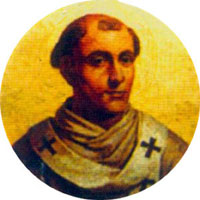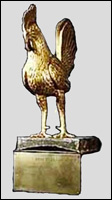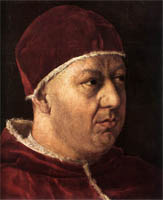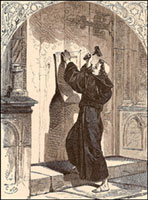COCK-A-DOODLE-DO....IN 850 AD, POPE LEO IV PLACED A ROOSTER ON TOP OF OLD ST. PETER'S BASILICA TO COMMEMORATE PETER'S DENYING CHRIST 3 TIMES! |
The symbol of the Babylonian Empire, as depicted in Daniel Chapter 7, is a lion with eagle's wings.
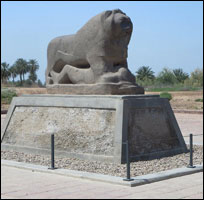 Statue of the Lion of Babylon in Iraq. |
|
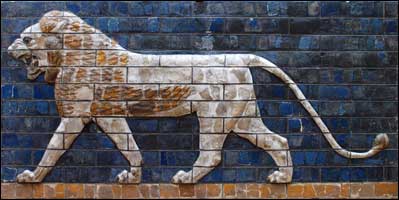 King Nebuchadnezzar of Babylon is depicted as a ferocious lion with eagle's wings. |
Here is a quote from the real Saint Peter, who never once set foot in the city of Roma:
Be sober, be vigilant (Gk. gregoreuo); because your adversary the devil, as a roaring lion, walketh about, seeking whom he may devour (I St. Peter 5:8).
In the year that baby Leo was born, the Papacy was also in its infancy. Popes did not take a throne name until Pope John II in 533, so Leo kept his birth name.
When Leo became Pope in 440, a serious rift was already beginning between Old Roma and New Roma or Constantinople. The Council of Chalcedon, held in 451, and attended by 600 bishops, declared that Old Roma held the primacy only because it was the imperial city.
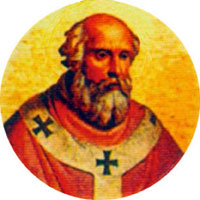 Pope Leo I (400–461). Pope from 440 to 461. |
|
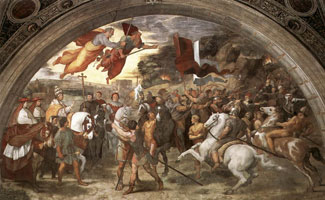 The famous meeting between Pope Leo and Attila the Hun in 452, by Raphael. |
There is an amazing continuity between pagan and Papal Roma. Ambitious Roman generals, who wanted to be Caesars, would bribe barbarian chiefs to attack the frontier. Then they would march out, defeat them, and return in triumph. The Romans were awestruck by the persuasive power of Pope Leo over the "Scourge of God" Attila the Hun!
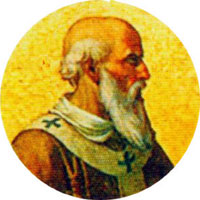 Pope Leo II (611– 683). Pope from 682 to 683. |
|
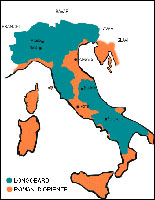 The Exarchate of Ravenna from 584 to 751. |
Pope Leo II is considered a "good Pope" because his reign only lasted from August 682 to June 683.
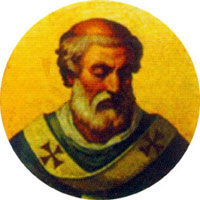 Pope Leo III. Pope from 795 to 816. |
|
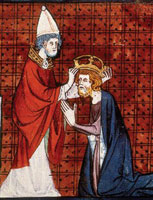 An artistic depiction of the crowning of Charlemagne by Pope Leo III. |
Leo was assaulted in Roma by partisans of the late Pope Adrian I, and fled to Charlemagne at Paderborn. The King of the Franks arbitrated the dispute, restoring Leo to his office. Leo subsequently crowned Charlemagne as "Holy Roman Emperor," which was not approved in Constantinople, although the Byzantines, occupied with their own defenses, were in no position to make much opposition.
|
|
|
Construction of the Basilica, built over the historical site of the Circus of Nero, began during the reign of Emperor Jesus Constantine. The name "Old St. Peter's Basilica" has been used since the construction of the current Basilica to distinguish the two buildings.
Immediately after Pope Leo went to St. Peter, Pope Joan, disguised as Pope John the Englishman, wore the triple crown under the name Pope John/Joan VII.
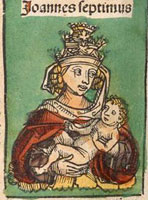 Pope Joan VII. Reigned from 855 to 857. |
|
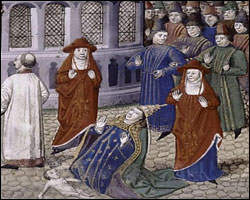 Medieval artistic rendition of Pope Joan giving birth. |
To hide the reign of the female Pope, a Pope Benedict III was inserted between the reigns of Pope Leo and Pope Nicholas I. The numbering system of the Pope Johns was also changed as there is no Pope John XX.
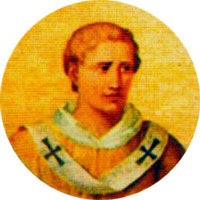 Pope Leo V. Pope from 903 to 904. |
|
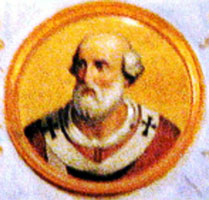 Pope Christopher I. Pope from 903 to 904. |
Both Popes were sent to St. Peter by the next pontiff named Sergius III. In Roma, the 10th century is known as "the rule of the harlots," or the pornocracy. That era is symbolized in the Apocalypse by the Congregation of Thyatira, when Jezebel was riding the Beast, and the Papacy was a veritable sewer of corruption.

Pope Leo VI. Pope from 928 to 929. |
|
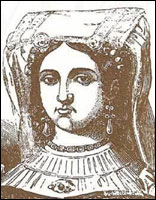 The infamous courtesan Marozia (890–937). |
The 5-year-reign of Pope John XI was considered a long reign during the 10th century when the life span of most pontiffs was very short indeed.
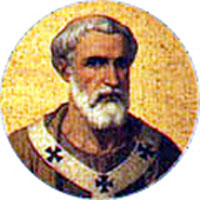 Pope Leo VII. Pope from 936 to 939. |
|
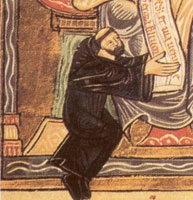 Monk Oddo of Cluny (880–942). |
The monasteries were also "boot camps" for Popes, as many of the pontiffs were "graduates" of the monasteries.
 Pope Leo VIII. Pope from June 964 to March 965. |
|
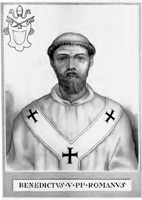 Pope Benedict V. Pope from May to June 964. |
Both Popes were succeeded by Pope John XIII. On Christmas Day in 967, Pope John XIII crowned Otto II—son of fake "Roman Emperor" Otto I—as co-emperor.
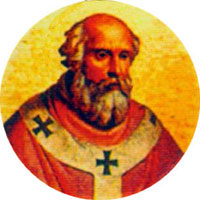 Pope Leo IX (1002–1254). Pope from 1049 to 1054. |
|
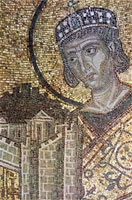 Michael I Cerularius (1000 –1159). Patriarch of Constantinople from 1043 to 1059. |
In September 1053, Pope Leo sent a letter to Ecumenical Patriarch Cerularius with a copy of the fake "Donation of Constantine." Naturally, the Patriarch rejected all the demands of the pontiff.
In 1054, Pope Leo sent 3 legates with a Bull of Excommunication for the Patriarch . . . and the entire Orthodox Church. They laid the Bull on the altar of Hagia Sophia . . . and then fled. In return, the Patriarch excommunicated the entire Latin Church or See of Roma. Open war was declared, which still continues to this day.
|
In January 1521, Pope Leo formally excommunicated the Saint by the Bull Decet Romanum Pontificem or It Pleases the Roman Pontiff. He also ordered fake "Roman Emperor" Charles V to enforce the Bull by arresting and burning Saint Martin Luther alive at the stake.
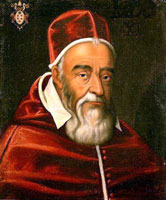 Pope Leo XI (1535–1605). Pope from April 1 to 27, 1605. |
|
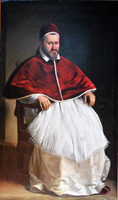 Pope Paul V (1550–1621). Pope from 1605 to 1621. |
Leo also canonized Ignatius Loyola, co-founder of the Jesuits, and Charles Borromeo. Had the Gunpowder Plot succeeded, there would have been no Pilgrim Fathers to sail on the Mayflower, and no New Jerusalem in the New World.
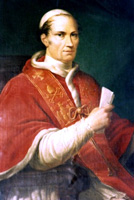 Pope Leo XII (1760–1829). Pope from 1823 to 1829. |
|
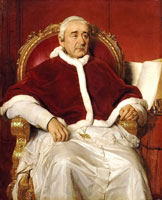 Pope Gregory XVI (1791–1846). Pope from 1831 to 1846. |
Every year ending in 9 is supposed to be "unlucky." Pope Leo was succeeded by Pope Pius VIII who only reigned for 20 months.
 Pope Leo XIII (1810–1903). Pope from 1878 to 1903. |
|
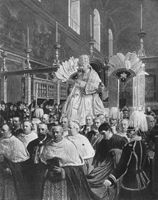 "Almighty God" carried in a procession. |
Here is a quote from the Great Encyclical Letters of Pope Leo XIII:
But since We hold upon this earth the place of God Almighty, who will have all men to be saved and to come to the knowledge of the truth, and now that Our advanced age and the bitterness of anxious cares urge Us on towards the end common to every mortal, We feel drawn to follow the example of Our Redeemer and Master, Jesus Christ, who, when about to return to heaven, implored of God, His Father, in earnest prayer, that His disciples and followers should be of one mind and of one heart. (The Great Encyclical Letters of Pope Leo XIII, p. 304).
After the Fall of the Papal States, the roaring lion began to concentrate all of his activities on the New World, especially the New Jerusalem. Before the end of time, Satan was determined to plant his tabernacle from sea to shining sea (Daniel 11:45).
Pope Leo XIII was the last Pope with named in the nightmarish Papal dynasty! The best way to rescue Catholics . . . and Muslims . . . from the Babylonian system is to present the true history of the Papal dynasty:
Flee out of the midst of Babylon, and deliver every man his soul: be not cut off in her iniquity, for it is the time of JEHOVAH's vengeance; he will render unto her a recompense (Jeremiah 51:6).
And I heard another voice from heaven saying, "Come out of her, my people, that ye be not partakers of her sins, and that ye receive not of her plagues" (Apocalypse 18:4).
Vital links
References
Norwich, John Julius. Absolute Monarchs: A History of the Papacy. Random House, New York, 2011.
Pope Leo XIII. The Great Encyclical Letters of Pope Leo XIII. Tan Books Publishers, Rockford, Illinois, 1902. Reprinted 1995.
Rappaport, Angelo S. The Love Affairs of the Vatican. Barnes & Nobles Books, New York, 1995. (Originally published in 1912).
Woodrow, Ralph. Babylon Mystery Religion Ancient and Modern. Ralph Woodrow Evangelistic Association. Riverside, CA., 1966.
